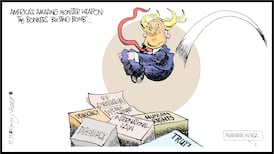BEFORE KRAKATOA blew its top in 1883, indirectly turning Percy French into a landscape painter (An Irishman’s Diary, yesterday), there was the eruption of Mount Tambora, also in Indonesia, in 1815. This too had global effects, being followed by the “year without a summer”. And on that occasion also, the clouds of volcanic ash had a silver lining for artists.
Silver is not one of the colours most associated with JMW Turner, in fact. But the golden tones in certain of his landscapes are thought to have been influenced by the ash-laden skies through which the sun occasionally forced itself in 1816. Writers were inspired too, if only because the miserable weather forced them to spend more time indoors.
Holidaying together in Switzerland, the Shelleys, Lord Byron, and a friend called John William Polidori were confined to their villa for days on end, lighting wood fires even though it was June. And it was while they were seated around the hearth one evening that Byron suggested they pass the time by each writing “a ghost story”.
He and his friend Percy gave up early, but Polidori persisted with a tale called The Vampyre, thereby founding a genre that would later be developed by Bram Stoker. More famously, Mary Shelley wrote her gothic masterpiece, Frankenstein. And not to be completely outdone, Byron reverted to his main discipline, writing a poem called Darkness, an apocalyptic vision of famine, despair, and violence in a benighted world.
“. . . Morn came and went – and came, and brought no day,/And men forgot their passions in the dread/Of this their desolation; and all hearts/ Were chill’d into a selfish prayer for light:/And they did live by watchfires – and the thrones,/The palaces of crowned kings – the huts,/The habitations of all things which dwell,/Were burnt for beacons; cities were consumed,/And men were gathered round their blazing homes/To look once more into each other’s face”.
The gloomy weather of 1816 spanned the globe: from Pennsylvania, where lakes were frozen in August, to China’s Yangtze Valley, where there was severe flooding caused by a catastrophic monsoon season. There were food riots in European cities, after the grain shortages begun by Napoleon’s 1812 retreat from Moscow worsened through a series of wet summers, until the summer that didn’t come at all.
But bad as things were elsewhere, perhaps it was in Ireland that Byron’s grim poetic vision came closest to reality. There, the terrible weather combined with the economic depression that followed the end of the Napoleonic wars to worsen the already desperate straits of the poor. The result was first famine and then a typhoid epidemic that eventually killed tens of thousands.
Among the many harrowing reports of the era is one from a Dr O'Leary in Kanturk, who wrote: "On the road leading from Cork, within a mile of the town, I visited a woman labouring under typhus; on her left lay a child very ill, at the foot of the bed another child just able to crawl about, and on her right the corpse of a third child who had died two days previously, which the unhappy mother could not get removed." In north Louth, meanwhile, the year without a summer framed the dreadful events at Wildgoose Lodge, which would in time make their own contribution to gothic literature.
They began in April 1816, when the eponymous hunting lodge was raided by “Ribbonmen”, one of many such incidents at the time. What was unique about this raid was that the man of house reported it to the authorities who, nervous about the rising militancy, hanged three named participants.
Six months later, close to Halloween – appropriately – the Ribbonmen in turn imposed their harsh sentence on the informant and his family. More than 100 of them, from Louth and surrounding counties, descended on the lodge at dead of night. Some travelled by rowing boat, such was the extent of flooding in the area. But fire was to be the element of their revenge.
In his famous (and somewhat fictionalised) short story, Wildgoose Lodge, William Carleton describes the demonic faces of the gang leaders, illuminated by the blazing house from which no one was allowed escape. Perhaps he had read Byron’s poem. But if he needed to recreate the burning from imagination, he had seen its equally grim aftermath at first hand.
Less than a year later, in the autumn of 1817, Carleton walked from Tyrone to Dublin, stopping with relatives in South Monaghan, close to the scene of the massacre.
By then, 18 men had been hanged for reputed involvement, including Patrick Devane, the gang-leader, who was despatched with Old Testament justice from a scaffold erected within the walls of the razed lodge. As a warning to others, the authorities then gibbeted the bodies in tarred sacks and displayed them at strategic locations in the countryside for months afterwards.
That scene was witnessed by Carleton and left a deep impression. The summer of 1817 is said to have been almost as bad as the one before, but by autumn the effects of the volcanic dust must have been abating. The season was “unusually hot”, Carlton reported, so that the tar on the sacks melted and they became “literally covered with fleas”. A side-effect of the horror, he added, was that nobody ate fruit in the area that year.
An exhibition of Percy French’s watercolours and other memorabilia is running at the Linenhall Library in Belfast










